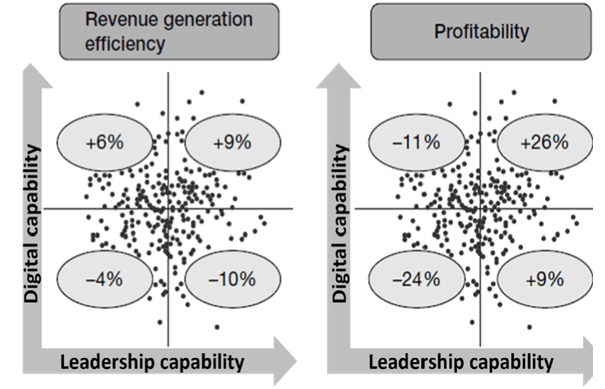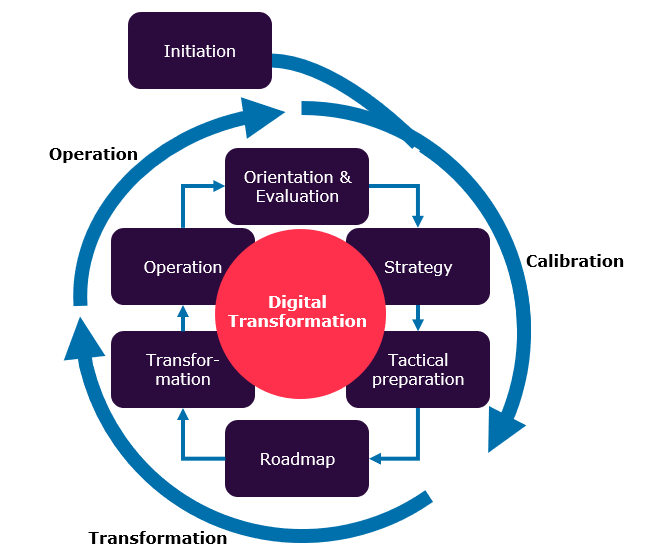In many organizations, business cannot do without digital assets. Products and services are driven by technology. An insurance company can no longer serve its customers without an app or the Internet. Consumers are enticed to buy products based on their search and click behavior on the Internet. More and more organizations are using APIs from other organizations to shape their own services. The dream of many organizations is to become a digital platform for other organizations. Nowadays this seems obvious, but digital transformation requires a lot from organizations, at all levels. So, what exactly is digital transformation? And above all, what are the success factors?
Our vision is largely based on the studies by Ross et al. (Digital Transformation) and Westerman et al. (Digital Leadership). The essence from these studies has been incorporated into this blog.
Digital transformation
Jean Ross, in “Designed for Digital” (Ross et al., 2019), distinguishes between “digital” and “digitize”. Digital is to be able to continuously develop new (online) customer-centric services driven by technology; digital value propositions. Those value propositions must be Agile and changeable.
Additionally operational backbone uses technology to digitize with the goal of standardizing business processes and making organizations operationally excellent. Digital organizations need to organize more and more around value propositions and not (only) around siloed business functions and entities.
Digital leadership
When you think of digital transformations, you quickly think of introducing new technology. That is what many organizations focus on. In Digital Leadership (Westerman et al., 2014) it is indicated that organizations only realize returns if they master both digital skills and digital leadership (see Figure 1). Digital leadership is the ability to create change in organizations and thus deliver new digital services to the market.

In the studies by Westerman et al. it has been shown that possessing both skills is an important prerequisite for real success in digital transformations. And although these studies are from several years back, they do demonstrate (again) that transforming organizations is more than just introducing new technology.
Trends in digital transformations
The results and handouts from Ross et al. and Westerman et al. clearly indicate that in a digital transformation, the organization must change with it. A culture must be created to learn and improve along the way. Fortunately, more and more knowledge about this is being shared and organizations are adopting best practices from each other. We encounter the following trends among organizations that are digitally transforming:
1. Value chain thinking and working
In shifting responsibilities to value proposition, the governance of the organization must also change. Governance is shifting to governing the chain (Value chain Management) rather than application or process. The balance between the ever-shorter time to market of new initiatives and the continuous need to change is what we call “dynamic stability”. Resilience of value chains is crucial part in this. A strategy aimed at increasing agility and resilience of the value chain ensures that service continuity remains predictable. This can make the difference between satisfied and dissatisfied customers, between being ahead in the market or behind.
2. Change management
A digital transformation is successful if there is good direction of the entire delivery process and if the change initiatives are maximally aligned with the defined goals. More and more organizations undergoing a digital transformation are investing in the effectiveness of the change cycle. This extends across the entire change process: from strategy formation (Calibration), development and implementation (Transformation) to operation and management (Operations); see figure 2. Because a digital transformation is focused on continuous change, it is not completed with one iteration.

3. Radical automation
A digital organization radically automates all its processes, with people primarily concerned with securing customer happiness rather than performing simple tasks. Complex development and change cycles act as barriers. Radical automation is also applied in the related change process. For example, software development can be highly automated using low- and no-code solutions.
Success Factors
A digital transformation is complex. Introducing new technology seems to be the top priority. However, the real success lies in other aspects. A successful digital transformation is:
People-oriented
Digital transformation is no easy task and requires attention on both technology and people. With new technology also comes changing processes, products/services and organizational governance. By now, we have developed sufficient methodologies and practices that provide structure for this. The value of a digital transformation is only achieved when the changed technology and processes are really adopted by the people using them. For example, when setting up a digital cloud workplace in a cloud environment, employee training and guidance is essential to get the most benefit out of this technology.
Target-oriented
A good transformation cycle (figure 2) is founded on a clear strategy and vision for digitalization. This must be focused on the organization’s digital value proposition which is continuously reviewed and adjusted when needed. Enterprise Architecture forms the connection between strategy and realization. This provides insights into how strategy and (new) technology are translated into design choices and guiding principles.
Value-oriented
Priorities in a digital transformation are determined on the value contribution of a proposition. Value is based on qualities (capabilities) that are important to the organization and are part of the strategy. Comply to the architecture is one such value. With Enterprise Portfolio Management as a tool, organizations can provide focus based on value, so they are able to allocate resources and budget appropriately.
This blog has been co-authored by Ton Eusterbrock and Remo Cantatore

 English | EN
English | EN 